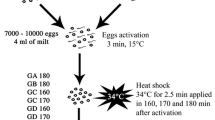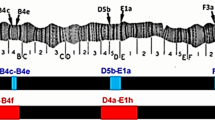Abstract
The results from two experiments on induced crossing-over in the germ cells of adultDrosophila melanogaster males, heterozygous for 12–13 third-chromosome mutant loci, support the premise that the F1 offspring recovered in the 6–8 day broods are derived mainly from cells that had been primary spermatocytes at the time of irradiation. This conclusion is also rather well supported by the results from similar experiments reported in the literature. The frequency of exchange in the third-chromosome following irradiation of the adult male is in the order of 0.01% for the 1–3 and 4–5 day broods, 0.15% for the 6–7 day broods and 0.31% for the 8th day brood in the pooled data from 18 experiments. The spontaneous rate for the third-chromosome is in the order of 0.001%.
The rather great variance among the experiments in time of recovery of the first crossovers and the frequency of exchange during the time of sampling the spermatocytes and definitive spermatogonia—ranging from none to a 20-fold increase (over the spontaneous rate) in the 6–8 day broods, and from none to a 10–50-fold increase from the 6–8 to the 9–11 day broods — can be attributed to the brood procedures or mating pressure, the effectiveness of ascertainment of crossing-over, particularly in the early broods, and the dosages used by the different investigators. The lack of a dosefrequency relationship in the broods prior to the period of peak sterility is due, at least in part, to lethal-loss of the cells with induced exchange.
The evidence from the two experiments also supports the premise that there may be different types of exchange-induction with a causal relationship between the time of induction and the site in the chromosome. The higher relative frequency of multiple crossovers and noncentric exchanges among the recombinants recovered in the 1–7 day broods, as compared to their frequency in the spermatogonial broods, suggests that there may be a difference in the mode of induction or transmission of recombinant chromosomes in different stages of spermatogenesis. The relatively high incidence of F1-sterility of the recombinants and homozygous lethality of the recombinant chromosomes points to the possibility that either the meiotically-induced exchanges are intrachromosomal aberrations frequently accompanied by duplications or deficiencies due to breakage at non-identical loci, or homologous chromosomes sensitive to the induction of exchange are more likely to be hypersensitive to the induction of genetic damage with detrimental fertility and viability effects.
Similar content being viewed by others
Author information
Authors and Affiliations
Rights and permissions
About this article
Cite this article
Hannah-Alava, A. Induced crossing-over in the presterile broods of drosophila melanogaster males. Genetica 39, 94–144 (1968). https://doi.org/10.1007/BF02324459
Received:
Issue Date:
DOI: https://doi.org/10.1007/BF02324459




